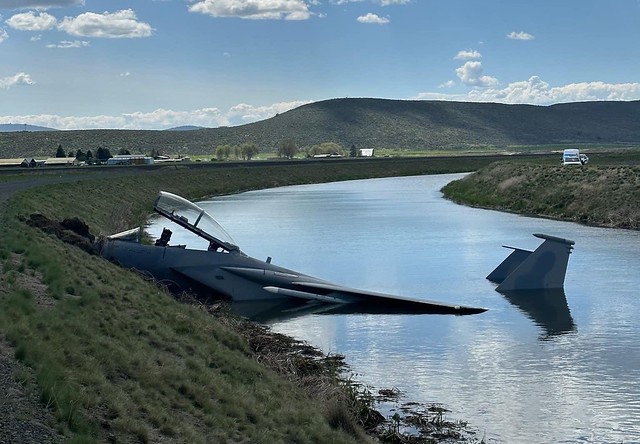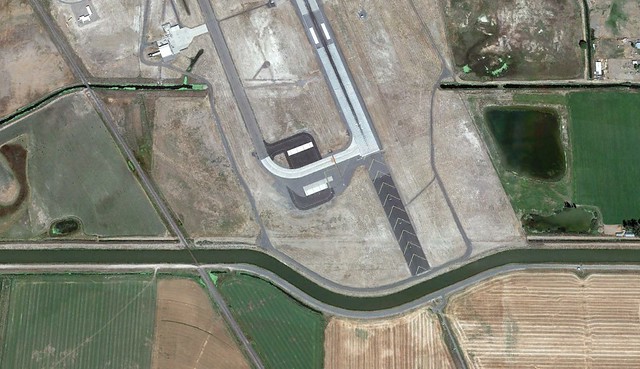Scroll to the end of the original post for updates. The original post is from May 17, 2023.
— Paul Woodford
An F-15 pilot earned a tactical callsign yesterday.

Probably not, though. It’s true that tactical callsigns often originate in screwups, but usually not from serious ones, and whatever this was, it looks serious to me. I also understand the mishap pilot is an instructor at the Air Force’s F-15 schoolhouse, so he or she already had one, and tactical callsign changes are rare.
What we know: an F-15 landing at Kingsley Field near Klamath Falls, Oregon, ran off the runway yesterday afternoon and wound up in an irrigation canal. Although it was an F-15D model with two seats, the rear seat was unoccupied and the single pilot was able to walk away afterward with only minor injuries. A mishap investigation board has been convened.
Kingsley Field, aka Crater Lake/Klamath Regional Airport, is home to the Oregon Air National Guard’s 173rd Fighter Wing. One of the wing’s missions is to train pilots newly assigned to the F-15: currently the F-15C but in the near future the new F-15EX. Because of its training mission, the wing is equipped with a few F-15D two-seaters like the one that wound up in the ditch yesterday.
Anything else, at this point, is speculation, and we’re not supposed to comment until the facts are known. Well, the further I get from the long arm of the Air Force, the less I’m inclined to observe the pieties, so I’m just gonna jump in the speculation canal with both feet. Up to my neck.
The pilot was returning from a routine training mission and according to an early press release had declared an emergency prior to landing. The pilot, who remains unidentified, is said to be an instructor, which indicates he or she is highly experienced in the Eagle.

There’s no official word on what manner of emergency the pilot experienced prior to landing, or why the pilot was unable to stop the aircraft on the runway. The runway in question is over 10,000 feet long, with another 700+ feet of overrun at the end. Minimum runway length for the F-15 (and for most other fighters operated by the Air Force) is 7,500 feet, and the majority of F-15 pilots have plenty of experience landing on those shorter strips. Ten thousand feet is a luxury, in fighter terms.
I suspect a combination of factors, not any one thing, led to yesterday’s mishap. If I’m correct, it’s a combination that never should have happened.
The F-15 has multiple hydraulic systems, and if one fails another will pick up the slack. There’s one system with no backup, though, and its failure can greatly complicate things when it comes to landing the airplane: the Utility A circuit. Utility A pressure is necessary to raise and lower the landing gear, also to operate nosewheel steering and wheel brakes. You need to put the gear down before landing, and once you’re on the ground you need brakes to help you slow to a stop (and nosewheel steering to keep you straight while you’re doing it).
Utility A failure, while rare, is a known malfunction, and many F-15 pilots have experienced it (I have, twice). The procedure is to declare an emergency and use the emergency handle to lower the gear (when you pull it the landing gear free-fall to the down position, where they’re held in position by over-center locks — which themselves sometimes fail). Once the gear is down you lower the tailhook in order to engage the approach end cable upon landing. When the hook snags the cable, you’ll come to an immediate stop. Should you miss the cable, a backup accumulator should provide enough emergency braking pressure to bring you to a stop on the runway (you’ll have to use differential brake pressure to stop in a straight line since you won’t have nosewheel steering). Should that fail — and it’s been known to happen — there’s another cable at the far end of the runway.
One thing that should never happen is that you find yourself rolling down the runway at speed with zero options remaining, helpless to stop. Hence the title of this post: Whoa Nellie!
Which is why I think an unfortunate (and unlikely) combination of factors put this jet and its pilot in the canal. Utility A failure is the one emergency I can think of that might result in being unable to stop — but only if other failures occur as well. Like for example the tailhook not lowering, or lowering with no pressure to hold it down so that it skips along the runway and misses both cables. And some sort of accumulator problem resulting in no emergency braking. Such a combination would have been unheard of in my day, but then again the F-15s I flew ranged in age from brand new to, at most, 15 years old. The jets they fly at Kingsley are well into their 40s, and failures of components and systems that never used to break are beginning to happen.
If you’re interested, you can read an earlier post of mine about F-15s, Utility A failure, and tailhook landings, which includes a photo of another Oregon ANG Eagle which, in May 2020, also suffered an unlikely combination of failures resulting in not only the tailhook missing the cable, accompanied by emergency braking and steering failure, but also the collapse of the right main landing gear and an excursion into the dirt alongside the runway. Apparently lightning can strike twice!
Update, June 5, 2024:
Click here or on the screengrab to read the article, but since it’ll soon be paywalled I’ll give you the synopsis.
The accident report has been released. That’s one of two investigation reports; the other is the mishap report, which is not released to the public and is used for safety purposes inside the USAF. The accident report is the one that assigns blame for legal purposes, and generally parallels the mishap report (minus the mishap report’s safety recommendations).
The accident sequence, outlined in the original post above, involved a particular F-15 hydraulic failure in flight: one that prevents normal landing gear lowering and also results in loss of normal braking and steering once on the ground. Every F-15 pilot is trained, in the event of this particular hydraulic failure, to declare an emergency, lower the gear by alternate means, drop the tailhook before landing, and to take the arresting cable at the approach end of the runway. Should the hook not engage the cable, pilots are trained to activate the emergency braking/steering system and stop straight ahead on the runway. Should that too fail, runways used by fighter aircraft (as this one was) have a second arresting cable at the departure end of the runway.
The accident report states that due to miscommunication between tower and the pilot experiencing the emergency, the tower controller lowered the arresting cable the pilot needed to stop the aircraft. The linked article doesn’t say why the pilot didn’t activate emergency braking/steering after missing the cable. The article doesn’t mention the second arresting cable, but clearly the emergency aircraft missed it too, so presumably the tower controller had lowered both.
Quoting now from the linked article:
After landing, the aircraft experienced a loss of normal braking so the pilot lowered the aircraft’s arresting hook to catch an arrestment cable at the end of the runway. During this process, the local tower controller misinterpreted the pilot’s intent and lowered the cable.
“The [aircraft] failed to make a successful barrier engagement, departed the runway surface and impacted an irrigation canal,” the report says. “The [pilot] safely egressed the aircraft.”
The investigation found the pilot did not engage the aircraft’s emergency braking/steering system in accordance with the checklist’s guidance, causing the incident. In addition, investigators blamed the pilot and controller for not effectively communicating, resulting in the controller lowering the arrestment cable.
During the years I flew the F-15, I twice experienced this emergency situation. Both times I followed checklist procedures, lowering the gear with the emergency handle, dropping the tailhook, and engaging the approach end cable. I never had to activate emergency braking and steering because the approach end cable stopped me both times. You know instantly if you snagged the cable, because you go from 150 knots to zero in a couple of seconds, thrown forward against your safety harness. Should you miss the cable, you’ll know that right away too, because now you’re rolling down the runway at speed.
What’s blowing my mind here is the pilot’s failure to activate emergency braking and steering system the instant he realized the hook didn’t snag the cable. With two miles of runway ahead, there was plenty of time to stop the jet with emergency brakes. The article doesn’t address that question, and I haven’t heard any scuttlebutt, so I remain of blown mind.
Hate to cast stones, but while the tower controller definitely screwed up, in my book splashing into that canal at the end of the runway is totally on the pilot.
Update, June 6, 2024:
A friend sends a second article, one that sheds additional light on the mishap sequence and the pilot’s intentions. From what I read, the pilot thought he might be able to land and stop normally and elected not to engage the approach end cable. He used up half the 10,000′ runway before deciding to lower the hook and take the departure end cable (which is when the tower controller, misunderstand a radio call, lowered the cable and took that last-ditch option away). And all because the pilot thought he’d likely blow a tire or two using the emergency braking/steering system … a far cheaper alternative to losing an entire jet. I say again: this one, IMHO, is entirely on the pilot.

Enough with the updates already! This time I’m leaving a comment. Several people have commented on this post, and the incident described in it, on Facebook F-15 groups. One of them, and I can’t verify this, says he knows the pilot, and that his tac callsign, even before this mishap, was “Skid.” If you’ve read my own history in the F-15, described in several Air-Minded posts on this blog, you’ll know my tac callsign is also Skid.
Weird how I’m suddenly feeling more forgiving toward the guy who ran off the end of the runway into a canal. A mistake anyone could have made!